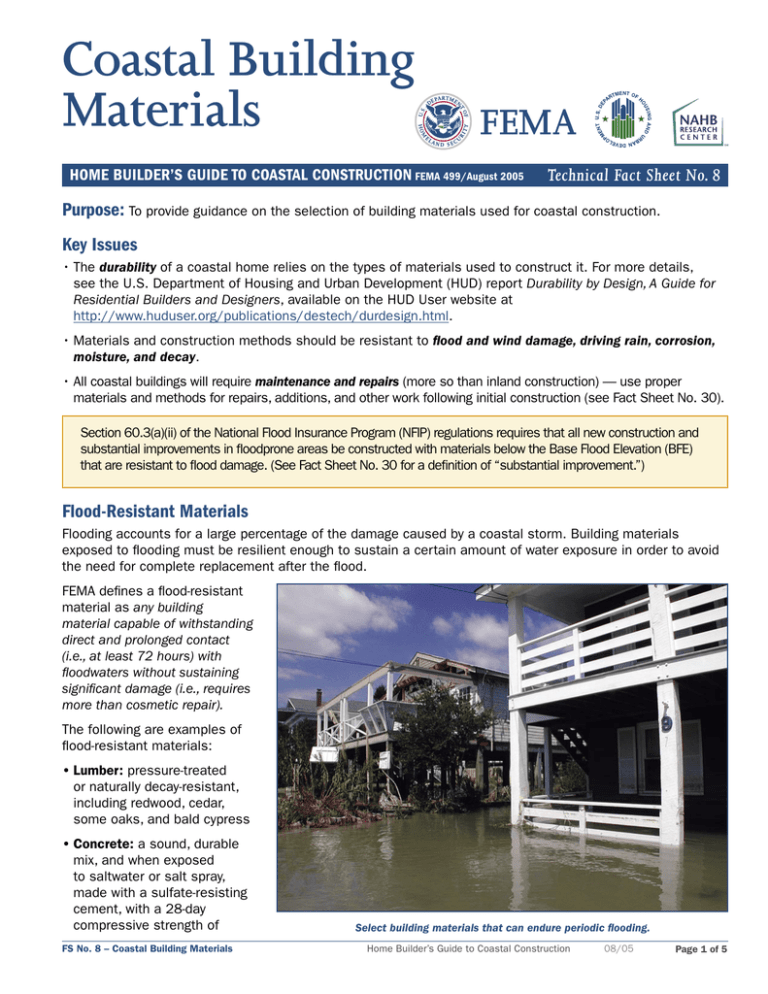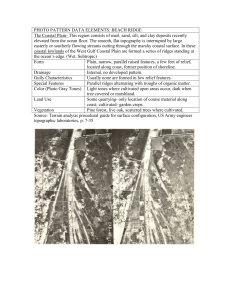Coastal Building Materials - Anthony Forest Products Co.
advertisement

Coastal Building Materials HOME BUILDER’S GUIDE TO COASTAL CONSTRUCTION FEMA 499/August 2005 Technical Fact Sheet No. 8 Purpose: To provide guidance on the selection of building materials used for coastal construction. Key Issues • The durability of a coastal home relies on the types of materials used to construct it. For more details, see the U.S. Department of Housing and Urban Development (HUD) report Durability by Design, A Guide for Residential Builders and Designers, available on the HUD User website at http://www.huduser.org/publications/destech/durdesign.html. • Materials and construction methods should be resistant to flood and wind damage, driving rain, corrosion, moisture, and decay. • All coastal buildings will require maintenance and repairs (more so than inland construction) — use proper materials and methods for repairs, additions, and other work following initial construction (see Fact Sheet No. 30). Section 60.3(a)(ii) of the National Flood Insurance Program (NFIP) regulations requires that all new construction and substantial improvements in floodprone areas be constructed with materials below the Base Flood Elevation (BFE) that are resistant to flood damage. (See Fact Sheet No. 30 for a definition of “substantial improvement.”) Flood-Resistant Materials Flooding accounts for a large percentage of the damage caused by a coastal storm. Building materials exposed to flooding must be resilient enough to sustain a certain amount of water exposure in order to avoid the need for complete replacement after the flood. FEMA defines a flood-resistant material as any building material capable of withstanding direct and prolonged contact (i.e., at least 72 hours) with floodwaters without sustaining significant damage (i.e., requires more than cosmetic repair). The following are examples of flood-resistant materials: • Lumber: pressure-treated or naturally decay-resistant, including redwood, cedar, some oaks, and bald cypress • Concrete: a sound, durable mix, and when exposed to saltwater or salt spray, made with a sulfate-resisting cement, with a 28-day compressive strength of FS No. 8 – Coastal Building Materials Select building materials that can endure periodic flooding. Home Builder’s Guide to Coastal Construction 08/05 Page 1 of 5 5,000 psi minimum and a water-cement ratio not higher than 0.40 – consult ACI 318-02, Building Code Requirements for Structural Concrete and Commentary, by the American Concrete Institute International • Masonry: reinforced and fully grouted • Structural Steel: coated to resist corrosion • Insulation: plastics, synthetics, and closed-cell foam, or other types approved by local building officials This table lists examples of flood-resistant materials used in coastal homes. FS No. 8 – Coastal Building Materials Home Builder’s Guide to Coastal Construction 08/05 Page 2 of 5 Many coastal jurisdictions make available a list of approved materials that can be used in coastal environments. Check for locally approved flood-resistant materials. Include all proposed construction and materials in approved plans. For guidance on testing specific materials, refer to NES Evaluation Protocol for Determination of FloodResistant Properties of Building Elements (NES, Inc. – http://www.nateval.org). Wind-Resistant Materials Homes in many coastal areas are often exposed to winds in excess of 90 mph (3-second peak gust). Choose building materials (e.g., roof shingles, siding, windows, doors, fasteners, and framing members) that are designed for use in high-wind areas. Examples: • shingles rated for high winds (see Fact Sheet No. 20) • double-hemmed vinyl siding (see Fact Sheet No. 25) • deformed-shank nails for sheathing attachments (see Fact Sheet No. 18) Select building materials that are suitable for the expected wind forces. • wind-resistant glazing (see Fact Sheet No. 22) • reinforced garage doors • tie-down connectors used throughout structure (from roof framing to foundation — see Fact Sheet Nos. 10 and 17) • wider framing members (2x6 instead of 2x4) The real issue is how long will a given material serve its intended purpose at a given home? The answer depends on the following: Remember: A wind-resistant material is only as good as its connection. Always use recommended fasteners and connection methods. • the material • where it is used in the home • whether installation techniques (e.g., drilling, cutting, bending) will compromise its resistance Corrosion and Decay Resistance Coastal environments are conducive to metal corrosion and moisture- and termite-related decay of other building materials. Metal corrosion is most pronounced on coastal homes (within 3,000 feet of the ocean), but moisture- and termite-related decay are prevalent throughout coastal areas. Corrosion-Resistant Metals Most jurisdictions require metal building hardware to be hot-dipped galvanized or stainless steel. Some local codes require protective coatings that are thicker than “off-the-shelf” products typically have. For example, a G90 zinc coating (0.75 mil on each face) may be required, which is thicker than the common G60 (0.5 mil on each face) coating. Recommendations • Use hot-dipped galvanized or stainless steel hardware. Reinforcing steel should be protected from corrosion by sound materials (masonry, mortar, grout, concrete) and good workmanship (see Fact Sheet No. 16). Use FS No. 8 – Coastal Building Materials The term "corrosion-resistant" is widely used but, by itself, is of little help to those specifying or evaluating materials for use in a coastal home. Every material resists corrosion to some extent, or conversely, every material corrodes. • its degree of exposure to salt air, moisture, and corrosive agents • whether maintenance required of the homeowner is performed The bottom line: do not blindly specify or accept a product just because it is labeled corrosion-resistant. Evaluate the nature of the material, its coating type and thickness (if applicable), and its performance in similar environments before determining whether it is suitable for a particular application. For guidance on the selection of metal hardware for use in coastal environments, consult an engineer with experience in corrosion protection. For more information about corrosion in coastal environments, see FEMA Technical Bulletin 8-96, Corrosion Protection for Metal Connectors in Coastal Areas for Structures Located in Special Flood Hazard Areas (see the Additional Resources section of this fact sheet). Home Builder’s Guide to Coastal Construction 08/05 Page 3 of 5 galvanized or epoxy-coated reinforcing steel in situations where the potential for corrosion is high (see Fact Sheet No. 14). • Avoid joining dissimilar metals, especially those with high galvanic potential (e.g., copper and steel). • Some wood preservatives should not be used in direct contact with galvanized metal. Verify that wood treatment is suitable for use with galvanized metal, or use stainless steel. • Metal-plate-connected trusses should not be exposed to the elements. Truss joints near vent openings are more susceptible to corrosion and may require increased corrosion protection. Moisture Resistance Materials resistant to moisture can greatly reduce maintenance and extend the life of a coastal home (however, by themselves, such materials cannot prevent all moisture damage. Proper design and installation of moisture barriers (see Fact Sheet No. 9) is also required). Recommendations • Control wood decay by separating wood from moisture, using preservative-treated wood, using naturally decayresistant wood, and applying protective wood finishes. • Use proper detailing of wood joints and construction to eliminate standing water and reduce moisture absorption by the wood (e.g., avoid exposure of end grain cuts, which absorb moisture up to 30 times faster than the sides of a wood member). • Do not use untreated wood in ground contact or highmoisture situations. Do not use untreated wood in direct contact with concrete. • Field-treat any cuts or drill holes that offer paths for moisture to enter wood members. Metals corrode at a much faster rate near the ocean. Always use well-protected hardware, such as this connector with thick galvanizing. (For information about pile-to-beam connections, see Fact Sheet No. 13). • For structural uses, employ concrete that is sound, dense, and durable; control cracks with welded wire fabric and/or reinforcing, as appropriate. • Use masonry, mortar, and grout that conform with the latest building codes. Termite Resistance Termite damage to wood construction occurs in many coastal areas (attack is most frequent and severe along the southeastern Atlantic and Gulf of Mexico shorelines, in California, and in Hawaii and other tropical areas). Termites can be controlled by soil treatment, termite shields, and the use of termite-resistant materials. Wood decay at the base of a wood post supported by concrete. FS No. 8 – Coastal Building Materials Home Builder’s Guide to Coastal Construction 08/05 Page 4 of 5 Recommendations • Incorporate termite control methods into design in conformance with requirements of the authority having jurisdiction. • Where a masonry foundation is used and anchorage to the foundation is required for uplift resistance, the upper block cores must usually be completely filled with grout, which may eliminate the requirement for termite shields (see Fact Sheet No. 14). • Use preservative-treated wood for foundations, sills, above-foundation elements, and floor framing. Additional Resources FEMA. NFIP Technical Bulletin 2-93, Flood-Resistant Materials Requirements for Buildings Located in Special Flood Hazard Areas. (http://www.fema.gov/fima/techbul.shtm) FEMA. NFIP Technical Bulletin 8-96, Corrosion Protection for Metal Connectors in Coastal Areas for Structures Located in Special Flood Hazard Areas. (http://www.fema.gov/fima/techbul.shtm) American Concrete Institute International. (http://www.aci-int.org/general/home.asp) American Wood-Preservers’ Association. (http://www.awpa.com) International Code Council Evaluation Service, Inc. Protocol for Testing the Flood Resistance of Materials. (http://www.icc-es.org/index.shtml) FS No. 8 – Coastal Building Materials Home Builder’s Guide to Coastal Construction 08/05 Page 5 of 5




